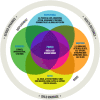Associations between child marriage and food insecurity in Zimbabwe: a participatory mixed methods study
- PMID: 38166715
- PMCID: PMC10759370
- DOI: 10.1186/s12889-023-17408-7
Associations between child marriage and food insecurity in Zimbabwe: a participatory mixed methods study
Abstract
Background: Child marriage is a global crisis underpinned by gender inequality and discrimination against girls. A small evidence base suggests that food insecurity crises can be both a driver and a consequence of child marriage. However, these linkages are still ambiguous. This paper aims to understand how food insecurity influences child marriage practices in Chiredzi, Zimbabwe.
Methods: Mixed methods, including participant-led storytelling via SenseMaker® and key informant interviews, were employed to examine the relationship between food insecurity and child marriage within a broader context of gender and socio-economic inequality. We explored the extent to which food insecurity elevates adolescent girls' risk of child marriage; and how food insecurity influences child marriage decision-making among caregivers and adolescents. Key patterns that were generated by SenseMaker participants' interpretations of their own stories were visually identified in the meta-data, and then further analyzed. Semi-structured guides were used to facilitate key informant interviews. Interviews were audio-recorded, and transcribed and translated to English, then imported into NVivo for coding and thematic analysis.
Results: A total of 1,668 community members participated in SenseMaker data collection, while 22 staff participated in interviews. Overall, we found that food insecurity was a primary concern among community members. Food insecurity was found to be among the contextual factors of deprivation that influenced parents' and adolescent girls' decision making around child marriage. Parents often forced their daughters into marriage to relieve the household economic burden. At the same time, adolescents are initiating their own marriages due to limited alternative survival opportunities and within the restraints imposed by food insecurity, poverty, abuse in the home, and parental migration. COVID-19 and climate hazards exacerbated food insecurity and child marriage, while education may act as a modifier that reduces girls' risk of marriage.
Conclusions: Our exploration of the associations between food insecurity and child marriage suggest that child marriage programming in humanitarian settings should be community-led and gender transformative to address the gender inequality that underpins child marriage and address the needs and priorities of adolescent girls. Further, programming must be responsive to the diverse risks and realities that adolescents face to address the intersecting levels of deprivation and elevate the capacities of adolescent girls, their families, and communities to prevent child marriage in food insecure settings.
Keywords: Adolescents; Child marriage; Child protection; Early marriage; Food insecurity; Forced marriage; GBV; Humanitarian; Nutrition; Zimbabwe.
© 2023. The Author(s).
Conflict of interest statement
The authors declare no competing interests.
Figures




Similar articles
-
Opportunities and challenges in preventing violence against adolescent girls through gender transformative, whole-family support programming in Northeast Nigeria.Confl Health. 2022 May 12;16(1):26. doi: 10.1186/s13031-022-00458-w. Confl Health. 2022. PMID: 35550180 Free PMC article.
-
Drivers and consequences of child marriage in a context of protracted displacement: a qualitative study among Syrian refugees in Egypt.BMC Public Health. 2021 Apr 7;21(1):674. doi: 10.1186/s12889-021-10718-8. BMC Public Health. 2021. PMID: 33827503 Free PMC article.
-
Transforming social norms to improve girl-child health and well-being: a realist evaluation of the Girls' Holistic Development program in rural Senegal.Reprod Health. 2021 Dec 3;18(1):243. doi: 10.1186/s12978-021-01295-5. Reprod Health. 2021. PMID: 34861876 Free PMC article.
-
Socio-cultural Norms and Gender Equality of Ethnic Minorities in Vietnam.J Racial Ethn Health Disparities. 2023 Oct;10(5):2136-2144. doi: 10.1007/s40615-022-01393-5. Epub 2022 Aug 25. J Racial Ethn Health Disparities. 2023. PMID: 36006587 Review.
-
Parental Feeding Practices in Families Experiencing Food Insecurity: A Scoping Review.Int J Environ Res Public Health. 2022 May 5;19(9):5604. doi: 10.3390/ijerph19095604. Int J Environ Res Public Health. 2022. PMID: 35564998 Free PMC article. Review.
References
-
- The Alliance for Child Protection in Humanitarian Action. Understanding Risk and Protective Factors in Humanitarian Crises: Towards a Preventive Approach to Child Protection in Humanitarian Action [Internet]. 2021. Available from: https://alliancecpha.org/sites/default/files/technical/attachments/risk_....
-
- Babu SC, Gajanan SN. Introduction to food security: concepts and measurement. Food Secur Poverty Nutr Policy Anal. 2022;3–26.
-
- Food and Agriculture Organization of the United Nations (FAO). Hunger Hotspots FAO-WFP early warnings on acute food insecurity, February to May 2022 Outlook [Internet]. 2021. Available from: http://www.fightfoodcrises.net/fileadmin/user_upload/fightfoodcrises/doc....
-
- Fu Y. Evidence Review on the Linkages Between Food Insecurity and Child Protection. 2022.
-
- Castañeda Carney I, Sabater L, Owren C, Boyer AE. Gender-based violence and environment linkages: The violence of inequality [Internet]. Report. 2020. Available from: https://portals.iucn.org/library/sites/library/files/documents/2020-002-....
Publication types
MeSH terms
LinkOut - more resources
Full Text Sources

